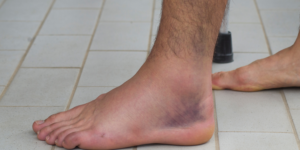Sprained feet are painful and uncomfortable when foot ligaments are strained or ruptured by a rapid twist or impact. Many small sprains can be treated at home with rest and self-care, but some require medical intervention. This tutorial covers three indicators that you should consult a doctor about a sprained foot to ensure correct diagnosis and treatment.
Severe Pain and Swelling
Sprained feet commonly have mild to moderate pain and swelling, which can be treated with RICE. However, severe and persistent discomfort requires medical attention. This level of discomfort may suggest a major sprain or fracture.
Here are some indicators that your pain and swelling may warrant a medical evaluation:
Inability to Bear Weight: If you cannot put any weight on the affected foot without significant pain, it’s crucial to seek medical attention. This may be a sign of a more severe sprain or a fracture.
Pain That Persists or Worsens: While some pain is expected with a sprained foot, it should gradually improve with rest and care. If the pain persists or becomes more intense after a few days, consult a healthcare professional.
Swelling That Doesn’t Subside: Swelling is a natural response to injury, but it should gradually decrease with proper care. If the swelling remains the same or increases, it’s a sign that there may be a more severe issue.
Noticeable Deformity: If your foot appears deformed or out of alignment, it could be a sign of a dislocation or a fracture rather than a simple sprain.
Bruising That Extends or Darkens
Sprained feet often bruise, but it should follow a pattern. Mild bruising may appear, then darken and fade within a day or two. If the bruising is significant, spreads quickly, or becomes dark, see a doctor.
Here are some concerning signs related to bruising:
Extensive Bruising: If the bruising covers a large portion of your foot or leg, it may indicate significant tissue damage and could be a sign of a more severe injury.
Rapid Spreading: If the bruise seems to be rapidly expanding, it might suggest a more significant issue, such as internal bleeding, and should be evaluated by a medical professional.
Dark or Blackish Color: Extremely dark or blackish bruises can indicate severe tissue damage or a possible vascular injury, which necessitates immediate medical attention.
Signs of Infection: If you notice any signs of infection around the bruised area, such as warmth, redness, pus, or fever, it’s crucial to see a doctor as infection can complicate the healing process.

Limited Range of Motion and Instability
Sprained feet can impede mobility and cause instability. The earliest stages of healing may involve some immobility, but a lack of improvement or new symptoms should necessitate a doctor’s appointment.
Signs of restricted movement and instability that require medical attention include:
Inability to Move or Bend the Foot: If you find it increasingly difficult to move or bend your foot, it could indicate a more severe injury. Reduced mobility could be due to damaged ligaments, tendons, or bones.
Chronic Instability: An unstable foot that continues to feel shaky, weak, or unsteady, despite rest and care, may signal the need for a professional evaluation.
New or Progressive Symptoms: If you experience new symptoms or notice that existing symptoms are getting worse, it’s essential to consult a doctor. These may include weakness, numbness, or tingling in the foot.
Persistent Instability After Healing: In some cases, even after the initial sprain has healed, you may continue to experience instability and recurrent sprains. This can be a sign of an underlying issue that requires investigation and treatment.
When to Seek Immediate Medical Attention
There are other indications that indicate a sprained foot that requires emergency medical attention:
Open Wound: A healthcare expert must clean and inspect an open wound, puncture, or major laceration from a sprained foot to prevent infection.
Dislocation: Do not adjust your foot if you suspect dislocation. Get immediate medical help.
Severe Pain and Immediate Swelling: If you have agonizing pain, quick swelling, and an inability to bear weight, you may have a fracture or other serious injury that needs emergency medical attention.
Loss of Pulse or Severe Numbness: Complete lack of pulse or significant numbness in the foot or toes may suggest poor circulation. Such situations require emergency attention.
Final Thoughts
Many sprained feet can be treated at home with rest, ice, compression, and elevation, but some require professional care. To avoid problems, see a doctor if you have significant pain, extensive bruising, limited mobility, or any of the other symptoms. Fast and effective medical treatment can help you heal faster and resume your regular routine.


